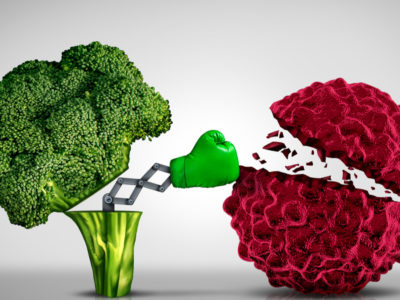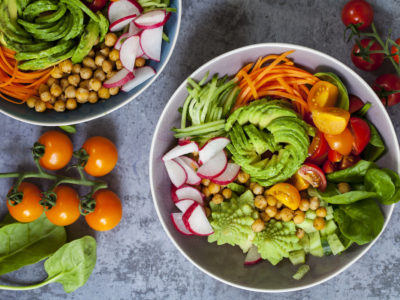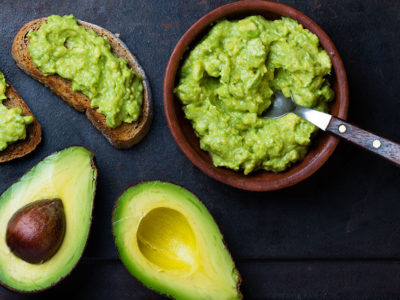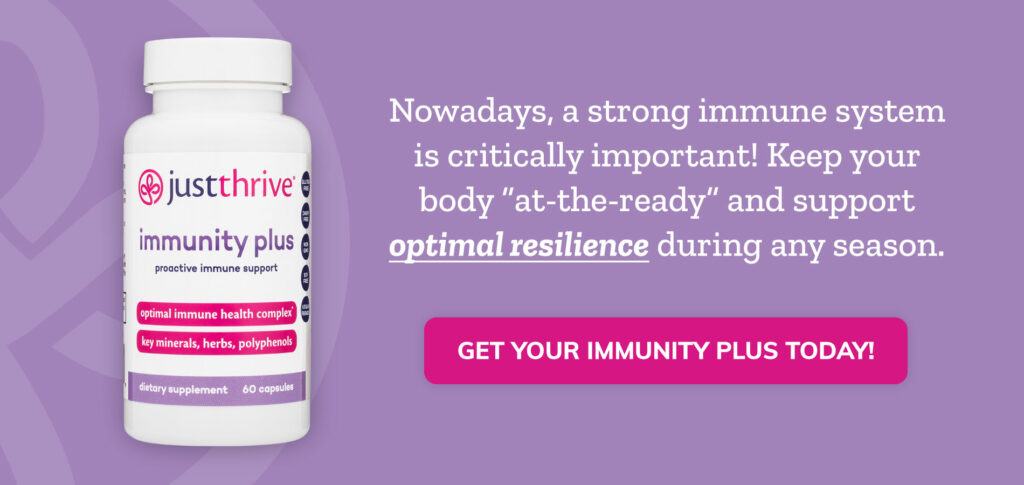Table of Contents[Hide][Show]
Ever heard the nutritional advice to “eat the rainbow”?
There are a number of reasons why this is solid guidance, from a greater variety of nutrients to a more balanced diet. But there’s one lesser-known benefit hiding in all that color.
Polyphenols.
Eating a diet that’s packed with brightly colored fruits and vegetables is one of the best ways to make sure you get enough of these antioxidant, anti-inflammatory powerhouses. And the more colorful your plate, the better—because you might be surprised at what these plant-based nutrients can do for you.
Let’s peek into the garden to explore what polyphenols are, how they support your health, and easy ways to add more to your diet.
What Are Polyphenols?
Polyphenols are plant-based compounds that can help you stay healthy. They occur naturally in certain foods, including fruits, vegetables, herbs, spices, and tea. Polyphenols are even found in dark chocolate and wine!
While polyphenols have multiple health benefits—which we’ll explore more in-depth later—they’re most widely recognized for their antioxidant and anti-inflammatory properties.
Types of Polyphenols
There are more than 8,000 unique kinds of polyphenols, which can be broken down into four main groups.
- Flavonoids are the most common type, accounting for about 60% of all polyphenols. They are typically found in foods such as apples, dark chocolate, onions, and red cabbage. Examples of flavonoids include catechins and quercetin.
- Next are the phenolic acids, which make up about 30% of polyphenols. These polyphenols include ferulic acid and chlorogenic acid, and they’re mostly found in coffee and cereal grains.
- Polyphenolic amides are another group of polyphenols, which include capsaicin in chili peppers and avenanthramides in oats.
- Finally, we have other polyphenols. The two most common, which you may have heard of, are resveratrol (found in grapes and red wine) and curcumin (found in turmeric). Some other examples include ellagic acid (berries), lignans (sesame seeds and whole grains), and stilbenes (grapes and berries).
The type of polyphenol depends largely on the foods they come from. It can also be affected by other factors, such as its origins, ripeness, and how it’s handled. For instance, the polyphenols in grapes may be affected by its varietal or the soil it’s grown in.
Related
Indulge In the Health Benefits of Chocolate
Explore the health benefits of chocolate, from its impressive antioxidant and nutrient profile, to its positive effects on the brain, heart, vision, weight management, and more.
How Much Polyphenols Should You Consume?
Polyphenols are readily available in a wide variety of foods, including everything from fruit and vegetables to nuts to chocolate and wine. They can form part of almost any diet. So chances are, you’re probably eating at least some polyphenol-containing foods already.
But is it enough?
At the moment, there isn’t an exact recommended amount of polyphenols per day. But for the most part, research suggests the best health results occur when you consume at least 500mg per day. Luckily, you can hit that goal by eating a healthy amount of fruits, vegetables, nuts, and whole grains. For example, just 3.5 ounces of blueberries contain 560 mg of polyphenols.
And you want to be sure you’re getting a healthy dose of polyphenols each day, because they have incredible health benefits—and little to no side effects!
Let’s look at the number one job polyphenols serve in your body, their antioxidant power.
Polyphenols: A Powerful Antioxidant
Most polyphenols work in your body as powerful antioxidants.
Your body is under constant attack by free radicals. These are highly unstable and reactive molecules with one or more unpaired electrons.
In their quest for an even number of electrons, free radicals attempt to “steal” them from other molecules, causing damage known as oxidative stress. This can lead to premature aging, diabetes, neurological diseases, and other medical issues, including cancer.
Unfortunately, free radicals are almost impossible to escape. They’re caused by some avoidable environmental factors, including UV radiation and smoking. But they’re also created as a byproduct of normal cell metabolism.
So, how do you protect your body from free radicals?
Antioxidants, including most polyphenols, can neutralize these harmful molecules, reducing or even protecting you completely from the potential damage they can cause.
Antioxidants are often found in the pigments of fruits and vegetables. If you really want to crank up that free radical-busting effect, choose extra bright or dark colored produce like apples, berries, broccoli, grapes, kale, spinach, squash, and tomatoes. And eating the skin, where those pigments and antioxidants are found, can lead to even better health.
But their antioxidant properties aren’t the only reason you should get plenty of polyphenols. Let’s explore some of their other benefits.
The Benefits of Polyphenols
If you aren’t eating polyphenols or if you aren’t getting enough of them, here are some reasons why you should increase your polyphenol intake.
Reduce Inflammation
One of the most important roles of polyphenols, aside from their free radical-fighting prowess, is managing inflammation.
Polyphenols do this by blocking enzymes and pathways in your body that could trigger inflammation. Over time, this contributes to a more balanced immune response and reduces the risk of chronic issues linked to inflammation, including heart disease, arthritis, asthma, neurological conditions, and some autoimmune diseases.
Related
Natural Pain Relief for Arthritis: 7 Simple Strategies
Discover natural pain relief for arthritis using simple lifestyle changes like diet, exercise, heat/cold therapy, herbs and more.
Improve Cardiac Health
Polyphenols aren’t just good for your taste buds; they’re also great for your heart.
As we mentioned earlier, polyphenols can help reduce chronic inflammation, which is a significant factor for heart disease.
Studies also show that polyphenols can support your cardiovascular health by managing your blood pressure and lowering your LDL (“bad” cholesterol) level.
And in their work as antioxidants, polyphenols reduce or even inhibit the production of OxLDL, or Oxidized LDL, an even more damaging version of LDL. OxLDL can cause a buildup of plaque, narrowing your arteries in a condition known as atherosclerosis. Over time, this restricts blood flow and can lead to heart attack or stroke.
Lower Blood Sugar
Polyphenols can also play a powerful role in managing your blood sugar.
Some studies suggest that polyphenols can control your blood sugar in four key ways:
- Slowing down carbohydrate digestion after meals
- Stimulating your body’s production of insulin, the hormone that transports sugar from your bloodstream to your cells
- Reducing glucose absorption
- Increasing insulin sensitivity
This lowers your blood sugar levels and helps prevent sugar spikes throughout the day. It provides other health benefits, as lower blood sugar levels reduce your risk of obesity and type 2 diabetes.
Protect Against Cancer
One other big way in which polyphenols can support your health: protecting you against cancer.
While there is no “magic cure” for cancer or anything you can do to prevent it entirely, current research shows that polyphenols can reduce your risk of cancer.
This is largely due to their antioxidant and anti-inflammatory properties, which can protect your cells from the type of free radical damage that could eventually lead to cancer.
And, while more research is needed, some studies also suggest that polyphenols may slow down or inhibit the development and growth of cancerous cells, particularly breast cancer.
Related
The Undeniable Link Between Diet and Cancer
This article explores how diet and cancer are connected, which foods you should eat to fight or even prevent cancer, and which foods you should avoid.
The Undeniable Link Between Diet and Cancer
Support Gut Health
Even your gut can benefit from polyphenols!
You already know that eating a diet filled with healthy fruits, vegetables, and nuts and seeds is good for you. But recent studies show that this is especially true when it comes to your gut health.
Your gut microbiome contains two types of bacteria: beneficial (“good”) and pathogenic (“bad”) bacteria. They live together in a precarious balance, vying for the limited space in your microbiome. In an ideal situation, the colonies of beneficial bacteria would flourish, crowding out the colonies of pathogenic bacteria.
How do polyphenols help create the right balance? Research indicates that they can support the growth of beneficial bacteria while also preventing the growth of pathogenic bacteria, bringing balance and health to your gut.
The Best Sources for Polyphenols
Ready to tap into those health benefits? Almost every fruit, vegetable, or nut contains polyphenols to some degree—but some are more concentrated than others.
Here are the best polyphenol-rich foods to add to your diet.
- Apples
- Berries
- Broccoli
- Carrots
- Chili peppers
- Cumin
- Dark chocolate (due to the cocoa)
- Flax seeds
- Ginger
- Ginkgo biloba
- Green tea
- Hazelnuts
- Oats
- Olives & olive oil
- Onions
- Pecans
- Red cabbage
- Sesame seeds
- Spinach
- Turmeric
- Walnuts
- Whole grains
That’s an extensive list, and chances are you already have at least some of these as part of your diet. But it’s important to remember that the type and concentration of polyphenols can vary tremendously, even within the same species.
Adding a polyphenol supplement like Just Thrive’s Immunity Plus can help ensure that your body is receiving the polyphenol support it needs.
Just one capsule contains polyphenols, herbs, and postbiotics specially chosen to counteract oxidative stress, support your gut and immune system, and encourage a healthy immune response.
With Just Thrive’s Immunity Plus and the right diet, you can help your body fight free radicals and enjoy the powerful benefits of polyphenols.
Final Thoughts
Polyphenols pack a serious health punch!
These powerful antioxidants can help protect you from free radicals and the potential damage they can cause. But their benefits don’t stop there. Polyphenols can play a major role in everything from managing inflammation and blood sugar to supporting your gut and inflammatory health.
And the best part? Polyphenols are easy to add to your daily diet through foods and supplements.
Keep your body healthy from the inside out with polyphenols.
You May Also Like…








